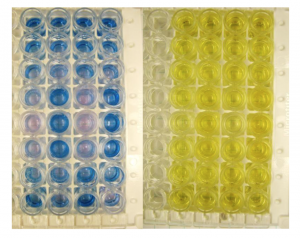 As 2014 draws to a close, here’s a look back at some of the things James and I posted this year. We try to post articles that appeal to every type of homebrewer. This includes articles that are aimed at advanced brewers, including articles that contained information on brewing science or were the results of scientific experiments. Here, in no particular order, are ten “advanced” homebrewing articles from 2014.
As 2014 draws to a close, here’s a look back at some of the things James and I posted this year. We try to post articles that appeal to every type of homebrewer. This includes articles that are aimed at advanced brewers, including articles that contained information on brewing science or were the results of scientific experiments. Here, in no particular order, are ten “advanced” homebrewing articles from 2014.
A six-part series on enzyme form and function, aiming to give advanced brewers a more sophisticated view of enzymes and how they act.
 A three-part series on tannins, how they enter the brewing stream, and what can be done to manage them.
A three-part series on tannins, how they enter the brewing stream, and what can be done to manage them.
An ongoing series about barley starch and how it is gelatinized and (coming soon) degraded in the mash.
Part of my series on choosing a mash method, this article explains each of the temperature rests in a step mash and when you should employ them.
Storing Wort Runs the Risk of Botulism
 Brewing is generally a safe pursuit. However, if you boil your wort, seal it in an airtight container, and store it at room temperature, you are creating the conditions for botulism bacteria to grow and potentially poison your wort. This article lead some readers to ask questions, which we answered in a separate article.
Brewing is generally a safe pursuit. However, if you boil your wort, seal it in an airtight container, and store it at room temperature, you are creating the conditions for botulism bacteria to grow and potentially poison your wort. This article lead some readers to ask questions, which we answered in a separate article.
Wort Boils Above 212 °F (100°C)
Wort has dissolved solids in it. As such, it boils above the temperature that pure water boil at.
 A three-part series, by Chris Hamilton, on whether Clarity Ferm yields gluten-free beer.
A three-part series, by Chris Hamilton, on whether Clarity Ferm yields gluten-free beer.
Different Yeast Strains Yield Different IBUs
If you ferment a bunch of different worts, all with the same amount of hops added, with different yeast strains, you end up with beers of varying IBUs. Chris White, of White Labs, and his crew did that and reported the preliminary results at the 2013 Dixie Cup.
There’s more than one way to produce a sour beer. Most commonly, microorganisms sour the beer during and after fermentation. Less commonly, the mash can be soured prior to wort production. There’s another option, though — souring the wort, and James explores that idea in this article.
Looking for an extended brewing project? How about a four-year plan to blend a gueze from 1-, 2-, and 3-year-old lambic? I’ve done it and I describe the process in this article.
—
Related articles
Brewing Science Articles from Year One
Top All-Grain Articles From Our First Year


Speak Your Mind